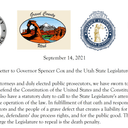Deterrence is one of the most commonly expressed reasons for use of the death penalty, both as a constitutional justification1 and as a public policy rationale. Elected officials have recently called the death penalty an “essential” deterrent to crime. The argument goes that if someone knows they could face the death penalty, they will not commit the crime. Following that reasoning would suggest that states with the death penalty are safer than states without it.
According to several metrics, states that impose the death penalty are not safer than states that do not use the death penalty. The data show that use is not correlated with lower murder rates; does not increase protections for law enforcement personnel; and does not meaningfully advance public safety.
But does the evidence show that the death penalty deters crime and keeps communities safer?
Answer: No. According to several metrics, states that impose the death penalty are not safer than states that do not use the death penalty. The data show that use is not correlated with lower murder rates; does not increase protections for law enforcement personnel; and does not meaningfully advance public safety.
Fact: Murder Rates Are Higher in Death Penalty States
Although murder rates do not perfectly represent how “safe” a given state is, they are often cited as key indica of safety, and aggravated murders are the only crimes for which the punishment may be constitutionally applied. Statistics show that murder rates are higher in states that have the death penalty. According to analysis by DPI based on FBI Uniform Crime Reports, in every year between 1990 to 2020, the murder rate in non-death penalty states was lower than in death penalty states. A 2023 study by Stephen Oliphant found a similar pattern in states whose governors paused its use. In four states that paused executions, none experienced an increase in murder rates attributable to the pause. In three of those states, the same study actually found a reduction in murder rates following the moratoria after controlling for other factors.
Looking internationally, in the European Union, where all countries have abolished the death penalty, every country has a lower murder rate than the United States. More broadly, as of 2018, of the eleven countries that had abolished the death penalty between 2008 and 2018, ten actually experienced a decline in murder rates post-abolition.
Fact: The Death Penalty Does Not Increase Protections for Law Enforcement
The intent of some state legislators is to specifically deter law enforcement killings by including killing a law enforcement officer as an “aggravating factor” — and thereby making a defendant eligible for the death penalty. However, there is no data that supports the theory that the death penalty will increase protection for law enforcement. According to a 2017 analysis by DPI of thirty years of FBI data on murders in the United States and murders of law enforcement personnel killed in the line of duty, the presence or absence of the death penalty had no effect on either murder rates generally or the rates at which law enforcement officers were killed. In fact, police officers are killed in the line of duty at a rate that is 1.37 times higher in death penalty states than in non-death penalty states; eight of the nine safest states for law enforcement do not have the death penalty.
Fact: The Death Penalty Does Not Advance Public Safety
Some law enforcement officials have argued that the death penalty has no deterrent value and does not increase public safety. When investigating serious crimes, they have found that use of the death penalty is too random for it to effectively deter individuals. People with serious mental impairments, trauma, or brain damage are also less likely to be deterred by the potential consequences of their actions. The circumstances that lead to a death sentence can vary greatly; often cases with similar fact patterns do not yield the same punishment. Scholarship supports this notion, finding that deterrence is largely driven by how certain an individual is that they will be punished, not the severity of the punishment. Studies that claim to show a deterrent effect from the death penalty have been criticized by the National Research Council of the National Academies for omitting key variables, improper statistical analysis, and missing data.
Miriam Krinsky, a former prosecutor and former executive director of Fair and Just Prosecution (FJP), argues that actually eliminating capital punishment would promote public safety by restoring a moral compass and community trust with prosecutors. She argues that individuals who are subjected to the death penalty have disproportionately experienced poverty, mental illness, trauma, or intellectual disability and are often subjected to racial disparities, prosecutorial misconduct, or their attorney’s failure to adequately represent them in court, leaving them unjustly vulnerable to extreme punishment. This sense of injustice in turn undermines community trust in the criminal justice system.
Daniel Nagin, Deterrence, in Reforming Criminal Justice: Bridging the Gap Between Scholarship and Reform, vol. 4, Punishment, Incarceration, and Release, Academy for Justice, Arizona State University (E. Luna, editor), October 26, 2017; Daniel Nagin and John V. Pepper, Deterrence and the Death Penalty, Committee on Law and Justice at the National Research Council, April 2012; Deterrence and the Death Penalty, National Research Council, April 18, 2012; Police-Recorded Offences by Offence Category; Eurostat, last updated April 23, 2025; Restoring the Death Penalty and Protecting Public Safety, The White House, January 20, 2025; Stephen Oliphant, Estimating the Effect of Death Penalty Moratoriums on Homicide Rates Using the Synthetic Control Method, Criminology and Public Policy, 2022; What Happens to Murder Rates when the Death Penalty is Scrapped? A Look at Eleven Countries Might Surprise You, Abdorrahman Boroumand Center, December 13, 2018.
-
Gregg v. Georgia, 428 U.S. 153, 186 (1976).



